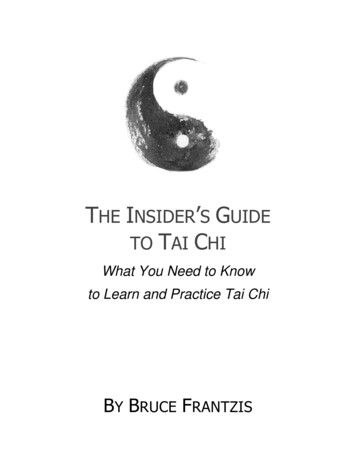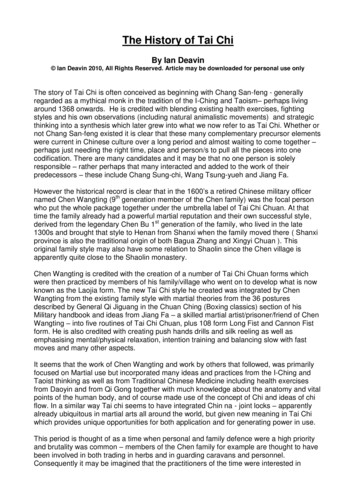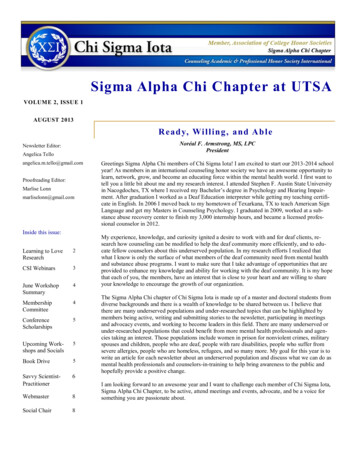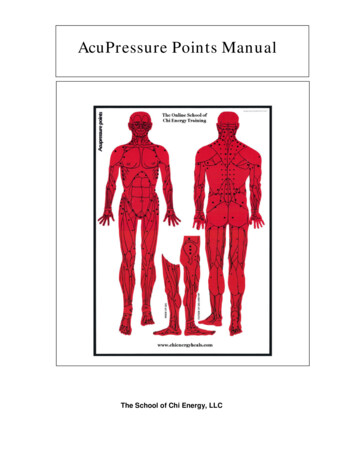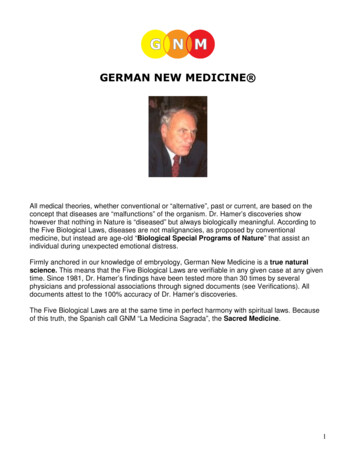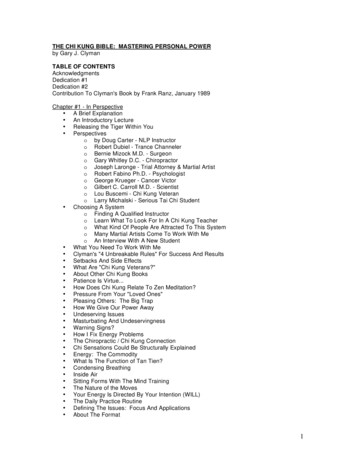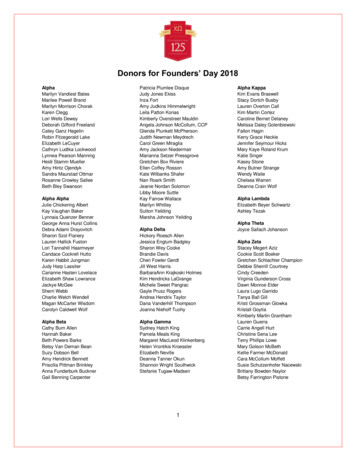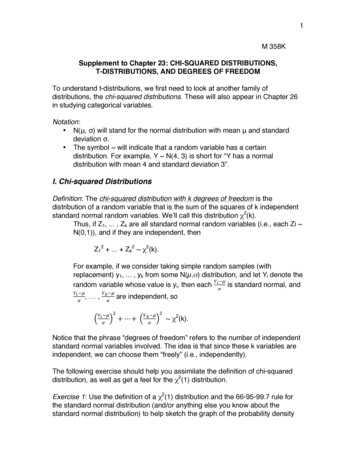
Transcription
1M 358KSupplement to Chapter 23: CHI-SQUARED DISTRIBUTIONS,T-DISTRIBUTIONS, AND DEGREES OF FREEDOMTo understand t-distributions, we first need to look at another family ofdistributions, the chi-squared distributions. These will also appear in Chapter 26in studying categorical variables.Notation: N(μ, σ) will stand for the normal distribution with mean μ and standarddeviation σ. The symbol will indicate that a random variable has a certaindistribution. For example, Y N(4, 3) is short for “Y has a normaldistribution with mean 4 and standard deviation 3”.I. Chi-squared DistributionsDefinition: The chi-squared distribution with k degrees of freedom is thedistribution of a random variable that is the sum of the squares of k independentstandard normal random variables. Weʼll call this distribution χ2(k).Thus, if Z1, . , Zk are all standard normal random variables (i.e., each Zi N(0,1)), and if they are independent, thenZ12 . Zk2 χ2(k).For example, if we consider taking simple random samples (withreplacement) y1, . , yk from some N(µ,σ) distribution, and let Yi denote the! !!random variable whose value is yi, then each !! is standard normal, and!! !!!, ,!! !!!!! !! !!are independent, so !! !! !! χ2(k).Notice that the phrase “degrees of freedom” refers to the number of independentstandard normal variables involved. The idea is that since these k variables areindependent, we can choose them “freely” (i.e., independently).The following exercise should help you assimilate the definition of chi-squareddistribution, as well as get a feel for the χ2(1) distribution.Exercise 1: Use the definition of a χ2(1) distribution and the 66-95-99.7 rule forthe standard normal distribution (and/or anything else you know about thestandard normal distribution) to help sketch the graph of the probability density
2function of a χ2(1) distribution. (For example, what can you conclude about theχ2(1) curve from the fact that about 68% of the area under the standard normalcurve lies between -1 and 1? What can you conclude about the χ2(1) curve fromthe fact that about 5% of the area under the standard normal lies beyond 2?)For k 1, itʼs harder to figure out what the χ2(k) distribution looks like just usingthe definition, but simulations using the definition can help. The following diagramshows histograms of four random samples of size 1000 from an N(0,1)distribution:These four samples were put in columns labeled st1, st2, st3, st4. Taking thesum of the squares of the first two of these columns then gives (using thedefinition of a chi-squared distribution with two degrees of freedom) a randomsample of size 1000 from a χ2(2) distribution. Similarly, adding the squares of thefirst three columns gives a random sample from a χ2(3) distribution, and formingthe column (st1)2 (st2)2 (st3)2 (st4)2 yields a random sample from a χ2(4)distribution. Histograms of these three samples from chi-squared distributions areshown below, with the sample from the χ2(2) distribution in the upper left, thesample from the χ2(3) distribution in the upper right, and the sample from theχ2(4) distribution in the lower left.The histograms show the shapes of the three distributions: the χ2(2) has a sharppeak at the left; the χ2(3) distribution has a less sharp peak not quite as far left;and the χ2(4) distribution has a still lower peak still a little further to the right. Allthree distributions are noticeably skewed to the right.
3There is a picture of a typical chi-squared distribution on p. A-113 of the text.Thought question: As k gets bigger and bigger, what type of distribution wouldyou expect the χ2(k) distribution to look more and more like? [Hint: A chi-squareddistribution is the sum of independent random variables.]Theorem: A χ2(1) random variable has mean 1 and variance 2.The proof of the theorem is beyond the scope of this course. It requires using a(rather messy) formula for the probability density function of a χ2(1) variable.Some courses in mathematical statistics include the proof.Exercise 2: Use the Theorem together with the definition of a χ2(k) distributionand properties of the mean and standard deviation to find the mean and varianceof a χ2(k) distribution.II. t DistributionsDefinition: The t distribution with k degrees of freedom is the distribution of aZrandom variable which is of the formwhereUki. Z N(0,1)ii.U χ2(k), andiii.Z and U are independent.
4Comment: Notice that this definition says that the notion of “degrees of freedom”for a t-distribution comes from the notion of degrees of freedom of a chi-squareddistribution: The degrees of freedom of a t-distribution are the number of squaresof independent normal random variables that go into making up the chi-squareddistribution occurring under the radical in the denominator of the t randomZvariable.UkTo see what a t-distribution looks like, we can use the four standard normalsamples of 1000 obtained above to simulate a t distribution with 3 degrees offreedom: We use column s1 as our sample from Z and (st2)2 (st3)2 (st4)2 as ourZsample from U to calculate a sample from the t distributionwith 3 degreesU3of freedom. The resulting histogram is:Note that this histogram shows a distribution similar to the t-model with 2 degreesof freedom shown on p. 554 of the textbook: Itʼs narrower in the middle than anormal curve would be, but has “heavier tails” – note in particular the outliers thatwould be very unusual in a normal distribution. The following normal probabilityplot of the simulated data draws attention to the outliers as well as the nonnormality. (The plot is quite typical of a normal probability plot for a distributionwith heavy tails on both sides.)
5III. Why the t-statistic introduced on p. 553 of the textbook has a tdistribution:1. General set-up and notation: Putting together the two parts of the definition oft-statistic in the box on p. 553 givesy !µt ,snwhere 𝑦 and s are, respectively, the mean and sample standard deviationcalculated from the sample y1, y2, , yn.To talk about the distribution of the t-statistic, we need to consider all possible1random samples of size n from the population for Y. Weʼll use the convention ofusing capital letters for random variables and small letters for their values for aparticular sample. In this case, we have three statistics involved: Y , S and T. Allthree have the same associated random process: Choose a random sample fromthe population for Y. Their values are as follows:The value of Y is the sample mean 𝑦 of the sample chosen.The value of S is the sample standard deviation s of the sample chosen.y !µThe value of T is the t-statistic t calculated for the sample chosen.snThe distributions of Y , S and T are called the sampling distributions of the mean,the sample standard deviation, and the t-statistic, respectively.
6Y !µ,Snexpressing the random variable T as a function of the random variables Y and S.Note that the formula for calculating t from the data gives the formula T Weʼll first discuss the t-statistic in the case where our underlying random variableY is normal, then extend to the more general situation stated in Chapter 23.2. The case of Y normal. For Y normal, we will use the following theorem:Theorem: If Y is normal with mean µ and standard deviation ! , and if we only2consider simple random samples with replacement , of fixed size n, thena) The (sampling) distribution of Y is normal with mean µ and standarddeviation !,nb) Y and S are independent random variables, andS2c) (n-1) 2 χ2(n-1)!The proof of this theorem is beyond the scope of this course, but may be foundin most textbooks on mathematical statistics. Note that (a) is a special case ofthe Central Limit Theorem. We will give some discussion of the plausibility ofparts (b) and (c) in the Comments section below.So for now suppose Y is a normal random variable with mean µ and standarddeviation ! :Y N(µ, ! ).By (a) of the Theorem, the sampling distribution of the sample mean Y (forsimple random samples with replacement, of fixed size n) is normal with mean µand standard deviation !:nY N(µ, !).nStandardizing Y then givesY !µ N(0,1).!n(*)But we donʼt know ! , so we need to approximate it by the sample standarddeviation s. It would be tempting to say that since s is approximately equal to ! ,
7Y !µ) should give us somethingsnapproximately normal. Unfortunately, there are two problems with this: First, using an approximation in the denominator of a fraction cansometimes make a big difference in what youʼre trying to approximate(See Footnote 3 for an example.) Second, we are using a different value of s for different samples (since sis calculated from the sample, just as the value of Y is.) This is why weneed to work with the random variable S rather than the individual samplestandard deviation s. In other words, we need to work with the randomY !µvariable T SnTo use the theorem, first apply a little algebra to to see thatthis substitution (in other words, consideringY !µ Sn!!!!!!!(**)Since Y is normal, the numerator in the right side of (**) is standard normal, asnoted in equation (*) above. Also, by (c) of the theorem, the denominator of theS2right side of (**) is of the form U (n ! 1) where U (n-1) 2 χ2(n-1). Since!altering random variables by subtracting constants or dividing by constants doesnot affect independence, (b) of the theorem implies that the numerator anddenominator of the right side of (**) are independent. Thus for Y normal, our testY !µstatistic T satisfies the definition of a t distribution with n-1 degrees ofSnfreedom.3. More generally: The textbook states (pp. 555 – 556) assumptions andconditions that are needed to use the t-model: The heading “Independence Assumption” on p. 555 includes anIndependence Assumption, a Randomization Condition, and the 10%Condition. These three essentially say that the sample is close enough toa simple random with replacement to make the theorem close enough totrue, still assuming normality of Y. The heading “Normal Population Assumption” on p. 556 consists of the“Nearly Normal Condition,” which essentially says that we can alsoweaken normality somewhat and still have the theorem close enough totrue for most practical purposes. (The rough idea here is that, by the
8central limit theorem, Y will still be close enough to normal to make thetheorem close enough to true.)The appropriateness of these conditions as good rules of thumb has beenestablished by a combination of mathematical theorems and simulations.4. Comments:i. To help convince yourself of the plausibility of Part (b) of the theorem, try asimulation as follows: Take a number of simple random samples from a normaldistribution and plot the resulting values of Y vs S. Here is the result from onesuch simulation:The left plot shows 𝑦 vs s for 1000 draws of a sample of size 25 from astandard normal distribution. The right plot shows 𝑦 vs s for 1000 draws ofa sample of size 25 from a skewed distribution. The left plot is elliptical innature, which is what is expected if the two variables plotted are indeedindependent. On the other hand, the right plot shows a noticeabledependence between Y and S: 𝑦 increases as s increases, and theconditional variance of Y (as indicated by the scatter) also increases as Sincreases.ii. To get a little insight into (c) of the Theorem, note first thatS2!! !! !! ,!!!!!!2which is indeed a sum of squares, but of n squares, not n-1. However, therandom variables being squared are not independent; the dependence arises!from the relationship 𝑌 ! !!!! 𝑌! . Using this relationship, it is possible to show(n-1)
9!!that (n-1)!! is indeed the sum of n-1 independent, standard normal randomvariables.Although the general proof is somewhat involved, the idea is fairly easy to seewhen n 2:First, a little algebra shows that (for n 2)𝑌! - 𝑌 !! !!!!and 𝑌! - 𝑌 !! !!!!.Plugging these into the formula for S2 (with n 2) then givesS2!! !! !! !! !(n-1) 2 !! 2 ! ! ! ! !!!(***)!Since Y1 and Y2 are independent and both are normal, Y1 - Y2 is alsonormal (by a theorem from probability).Since Y1 and Y2 have the same distribution,E(Y1 - Y2) E(Y1) - E(Y2) 0Using independence of Y1 and Y2, we can also calculateVar(Y1 - Y2) Var(Y1) Var(Y2) 2𝜎 !! !!Standardizing Y1 - Y2 then shows that ! !!! is standard normal, soequation (***) shows that (n-1)S2 χ2(1) when n 2.!2Footnotes1. “Random” is admittedly a little vague here. In section 2, interpret it to mean“simple random sample with replacement.” (See also Footnote 2). In section 3,interpret random to mean “Fitting the conditions and assumptions for the tmodel.”2. Technically, the requirements are that the random variables Y1, Y2, , Ynrepresenting the first, second, etc. values in the sample are “independent andidentically distributed” (abbreviated as iid), which means they are independentand have the same distribution (i.e., the same probability density function).3. Consider, for example, using 0.011 as an approximation of 0.01 whenestimating 1/0.01. Although 0.011 differs from 0.01 by only 0.001, when we usethe approximation in the denominator, we get 1/0.011 90. 90, which differs bymore than 9 from 1/0.01 100 – a difference almost 3 orders of magnitudegreater than the difference between 0.01 and 0.001.
Supplement to Chapter 23: CHI-SQUARED DISTRIBUTIONS, T-DISTRIBUTIONS, AND DEGREES OF FREEDOM To understand t-distributions, we first need to look at another family of distributions, the chi-squared distributions. These will also appear in Chapter 26 in studying categorical variables. Notation:File Size: 1MBPage Count: 9
